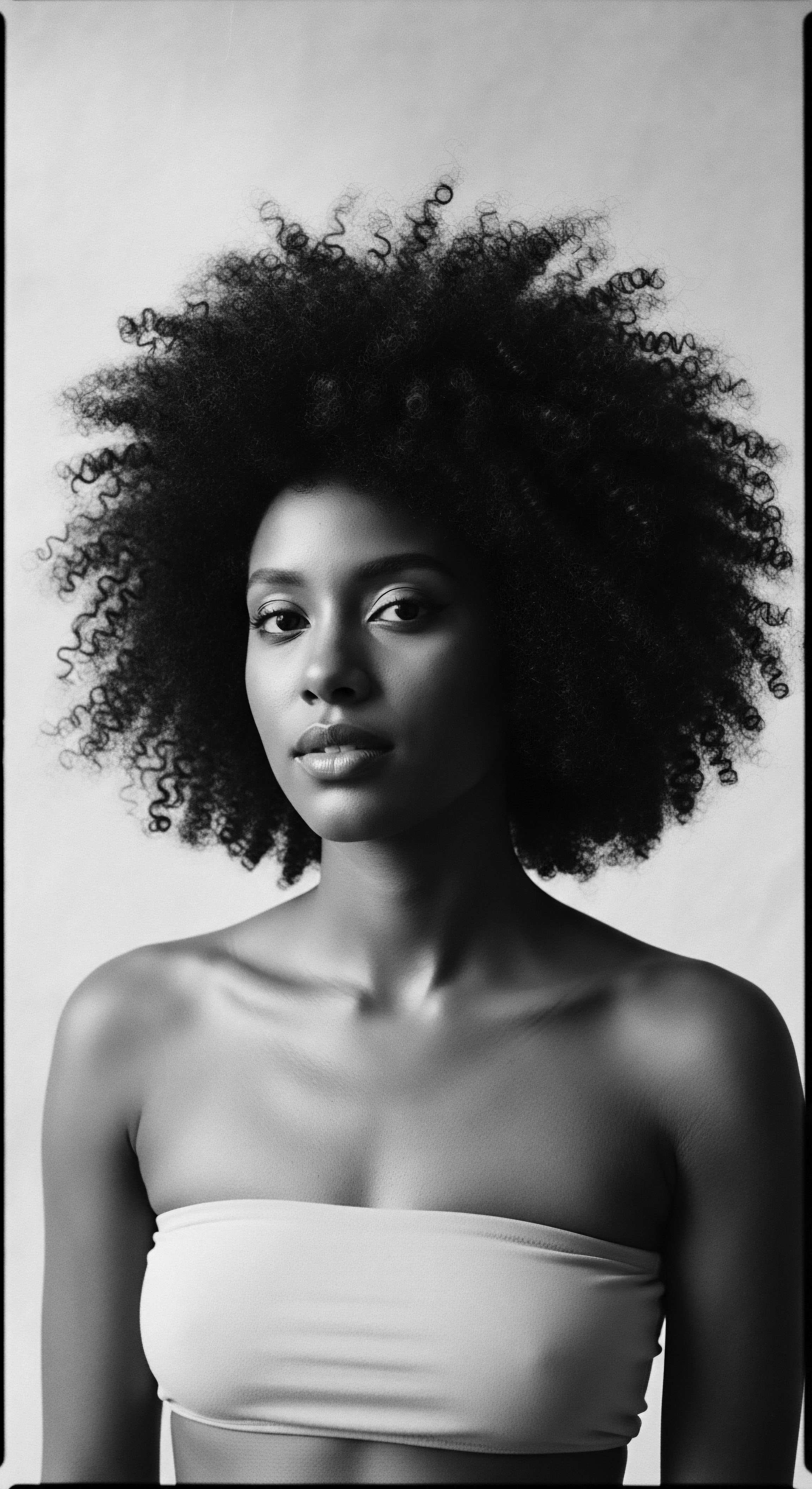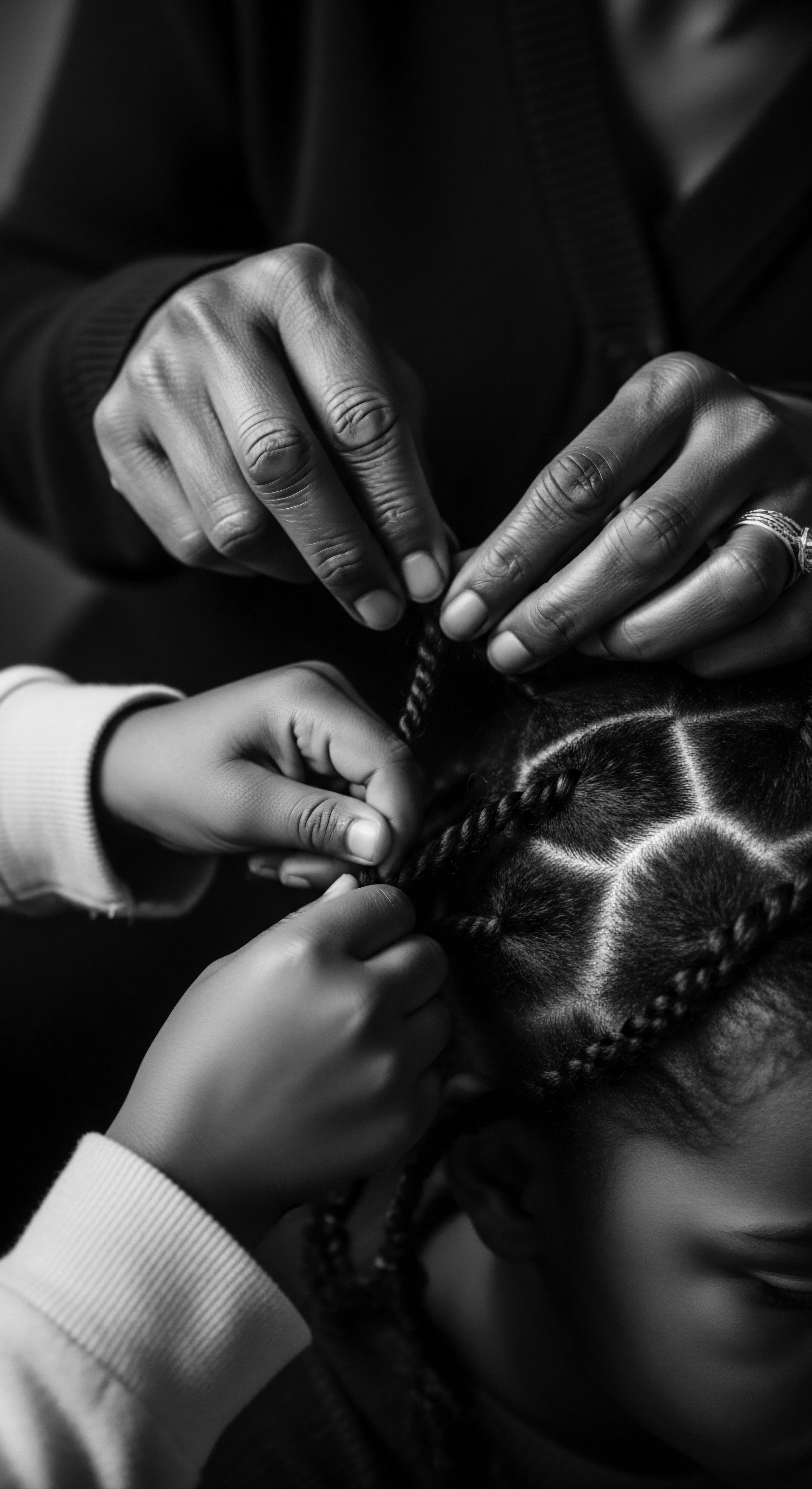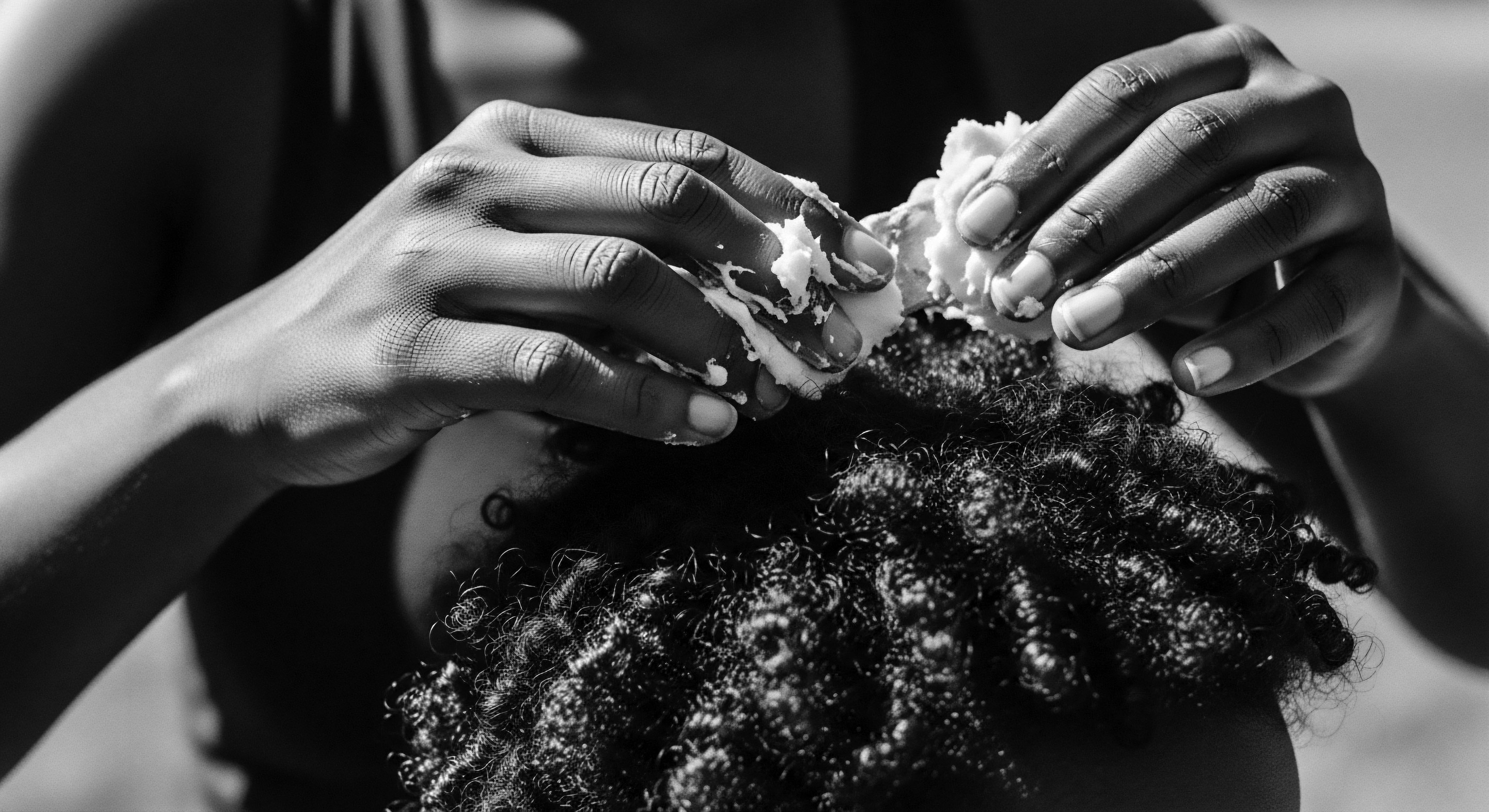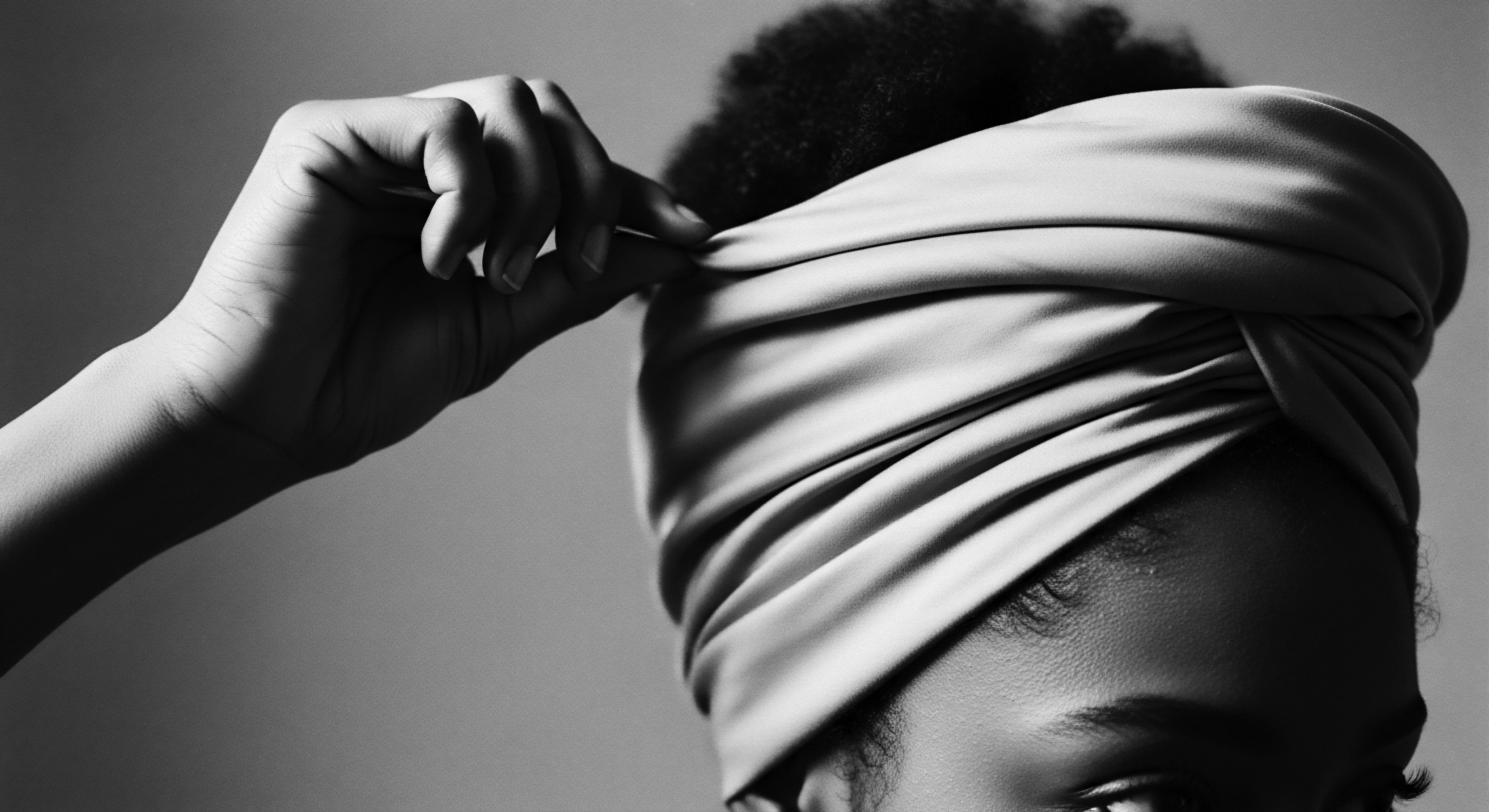
Fundamentals
The very notion of ‘Sericin Protein’ may at first appear as a whisper from the laboratories of contemporary science, a term belonging solely to the precise language of biochemistry. Yet, to truly grasp its deep meaning and its connection to the living legacy of textured hair, one must journey beyond the sterile confines of modern definition and listen for its echoes within ancestral wisdom. At its most fundamental, Sericin is a globular protein, a natural glue, if you will, that binds the fibroin strands of silk together, forming the silkworm’s protective cocoon. This humble protein, often discarded in commercial silk processing to achieve that familiar lustrous sheen, holds within its molecular structure a profound capacity for nurturing and shielding.
Consider the silkworm’s cocoon, a marvel of natural engineering. It is a testament to nature’s protective design, a resilient shelter against the elements. Sericin, the outer layer of this biological sanctuary, is not merely a structural component; it is the first line of defense, a guardian.
Its natural adherence and film-forming properties are precisely what grant the cocoon its integrity and resistance to external stressors. For those beginning to explore the world of hair science, particularly as it pertains to the unique needs of curls, coils, and waves, understanding Sericin starts with recognizing this elemental function ❉ it is a natural protector, a gentle sealant.
In its raw, unrefined state, Sericin envelops the silk fibroin, offering a layer of sustenance and defense. This inherent characteristic, the ability to coat and cling, provides a foundational insight into its utility for hair. When we speak of its simplest designation, Sericin is the component of silk that offers a comforting embrace, a protective veil. Its very existence speaks to a natural design for safeguarding, a concept that resonates deeply with the ancestral practices of hair care that prioritized preservation and fortification against the rigors of daily life and environmental challenges.
Sericin Protein, at its heart, is nature’s protective sealant, a fundamental guardian born from the silkworm’s cocoon.
The early human encounters with silk, long before its chemical components were isolated and named, undoubtedly recognized its unique qualities. The smooth touch, the subtle sheen, and the resilience of silk fabric were observed and valued. Though the ancient practitioners of hair care did not utter the term ‘Sericin,’ their intuition guided them towards materials and methods that mirrored its beneficial properties. The understanding of this protein begins not with a complex chemical formula, but with an appreciation for its elemental role in nature’s protective artistry.

Intermediate
Moving beyond the foundational insights, our understanding of Sericin Protein deepens as we consider its specific interactions with the delicate architecture of textured hair. This is where the wisdom of ancestral care traditions begins to converge with contemporary scientific observation, creating a richer, more comprehensive explanation of this protein’s meaning and significance. Sericin, with its unique amino acid composition, possesses a remarkable affinity for keratin, the primary protein component of human hair. This affinity allows it to form a delicate, invisible film upon the hair shaft, acting as a natural emollient and fortifier.
For curls, coils, and waves, which often possess a more open cuticle layer, this film-forming capability holds particular importance. The natural twists and turns of textured hair mean that its outer cuticle, the protective shingle-like layer, can be more prone to lifting, leading to increased moisture loss and vulnerability to external aggressors. Sericin steps in as a gentle mender, helping to smooth the cuticle, thereby reducing porosity and enhancing the hair’s capacity to retain vital hydration. This action mirrors the intentions behind countless ancestral practices that sought to seal moisture into the hair and protect its integrity.
Consider the ancestral use of plant mucilages, derived from sources like Flaxseed, Okra, or Aloe Vera, in various African and diasporic hair traditions. These botanical extracts, while chemically distinct from Sericin, share a functional commonality ❉ they form a protective, moisture-retaining layer on the hair. The elders, through generations of observation and practice, understood the calming effect these natural “gels” had on hair, taming frizz and lending a supple feel. Our modern understanding of Sericin, with its precise protein structure, provides a scientific validation for these age-old wisdoms, offering a clearer elucidation of why such practices brought forth desired results.
Sericin’s ability to coat and seal the hair cuticle offers a scientific echo of ancestral moisture-retention practices.
The application of Sericin in contemporary hair care products is not merely a trend; it represents a continuation of an ancient dialogue between humanity and nature’s offerings. Its molecular structure, rich in hydroxyl groups, allows it to bind water molecules, acting as a natural humectant. This means it draws moisture from the environment and holds it close to the hair, a profound benefit for hair types perpetually seeking hydration. The designation of Sericin as a beneficial ingredient stems from this dual capacity ❉ it protects the hair’s surface while simultaneously bolstering its internal moisture content.
The careful extraction of Sericin, often from the outer layers of the silk cocoon, represents a conscious choice to honor the full potential of this natural gift. It is a testament to the ongoing exploration of natural elements for holistic well-being, a journey that has roots stretching back through countless generations. The deeper meaning of Sericin for textured hair lies in its ability to offer a gentle, yet effective, layer of defense and hydration, qualities that have always been at the heart of conscious hair care.
The exploration of Sericin at this intermediate level allows us to appreciate its role not just as a singular protein, but as a concept that bridges the gap between ancient intuition and modern scientific precision. It serves as a reminder that the needs of textured hair, particularly for protection and moisture, are timeless, and the solutions, whether found in a silkworm’s cocoon or a grandmother’s garden, often align in their fundamental aims.

Academic
To approach Sericin Protein from an academic vantage point necessitates a rigorous examination of its biochemical properties, its nuanced interactions at the cellular and molecular levels, and its profound implications within the broader discourse of biomaterials and dermatological science, particularly as these intersect with the unique physiology and heritage of textured hair. Sericin, a complex macromolecule, is a family of hydrophilic globular proteins produced by the silkworm, Bombyx mori. It constitutes approximately 25-30% of the silk fiber by weight, enveloping the core fibroin protein.
Its amino acid profile is notably rich in serine (approximately 30-40%), aspartic acid, and glycine, contributing to its highly polar nature and extensive hydrogen bonding capacity. This specific composition underpins its exceptional hygroscopic properties, allowing it to absorb and retain a significant amount of water, a characteristic of paramount importance for the hydration of hair fibers.
The biological function of Sericin within the silkworm cocoon is multifaceted ❉ it serves as a natural adhesive, binding the fibroin filaments, and concurrently acts as a protective barrier against external enzymatic degradation, microbial invasion, and environmental stressors such as UV radiation and mechanical abrasion. When applied to human hair, particularly the intricate morphology of textured hair, Sericin’s high affinity for keratin—mediated by hydrogen bonding and electrostatic interactions between its polar side chains and the charged groups on the hair surface—enables it to form a semi-occlusive, biocompatible film. This film acts as an external scaffold, smoothing the often-lifted cuticle scales characteristic of curly and coily hair types, thereby reducing inter-fiber friction, mitigating cuticle damage, and decreasing porosity. The outcome is a significant reduction in moisture evaporation from the hair shaft, a critical factor in maintaining the tensile strength and elasticity of textured hair, which is inherently prone to dryness and breakage.

Ancestral Understanding of Hair Protection and Sericin’s Affirmation
The academic investigation into Sericin’s mechanisms provides a compelling scientific affirmation of ancestral practices that, without the benefit of molecular biology, intuitively understood the necessity of protecting and hydrating textured hair. While the term ‘Sericin Protein’ is a modern scientific construct, the principles of protection and moisture retention that it embodies have been central to Black and mixed-race hair heritage for millennia. Consider the profound cultural and functional significance of headwraps across the African diaspora. These coverings, often crafted from smooth, tightly woven materials such as silk or finely spun cotton, were not merely decorative; they served as vital protective measures for hair.
Historical accounts and ethnographic studies underscore the deliberate choice of materials for headwraps. For instance, in many West African societies and among enslaved and free Black communities in the Americas, the headwrap became a symbol of identity, resilience, and also a practical tool for hair preservation. The smooth surface of silk, or the polished finish of certain cottons, significantly reduced the mechanical friction that coarse or tightly coiled hair experienced against rougher fabrics or environmental elements. This reduction in friction directly translates to less cuticle damage, less tangling, and consequently, reduced breakage.
The very act of wrapping hair in such materials was an ancestral form of protective styling, a testament to an embodied knowledge of hair mechanics and moisture preservation. This practice, while not involving the direct application of Sericin, directly aligns with Sericin’s modern-day utility in creating a smooth, protective surface on the hair shaft to minimize friction and seal in moisture.
The ancestral practice of headwrapping with smooth fabrics profoundly mirrors Sericin’s protective qualities, validating an ancient wisdom through modern science.
A specific historical example illustrating this intuitive understanding can be observed in the widespread adoption of Silk Bonnets and Scarves among Black women in the American South following emancipation. While the explicit scientific understanding of protein structures was absent, the experiential knowledge passed down through generations highlighted the efficacy of smooth coverings in maintaining hair health overnight and during daily activities. Dr. T.
Denean Sharpley-Whiting, in her work exploring Black women’s beauty culture, alludes to the practical ingenuity embedded in these practices, noting how such coverings safeguarded elaborate styles and prevented dryness and breakage. This cultural practice, born of necessity and passed through oral traditions, functioned as a macro-level protective mechanism, paralleling the micro-level protection offered by Sericin at the hair fiber’s surface. The enduring prevalence of silk and satin bonnets in contemporary textured hair care unequivocally demonstrates the continuity of this ancestral wisdom.
The exploration of Sericin’s meaning, therefore, transcends its chemical definition; it becomes a lens through which we can appreciate the profound, often unarticulated, scientific insights embedded within ancestral hair care traditions. The protein’s capacity to form a moisture-retaining, friction-reducing film on hair provides a biochemical explanation for the success of practices that prioritized smoothness, protection, and hydration.

Sericin’s Role in Hair Fiber Integrity and Environmental Resilience
From an academic standpoint, the implications of Sericin extend to its potential in mitigating the impact of environmental aggressors on hair. Textured hair, due to its unique structural characteristics, can be more susceptible to oxidative stress and damage from UV radiation. Sericin has been shown to possess antioxidant properties, attributed to its ability to scavenge free radicals and chelate metal ions.
This protective capacity adds another layer to its utility in hair care, moving beyond mere surface conditioning to active defense. The significance of this lies in its potential to bolster the hair’s inherent resilience, a quality deeply valued in hair care traditions that sought to preserve hair’s vitality over time, often in challenging climates.
Furthermore, the adhesive nature of Sericin allows it to selectively bind to damaged areas of the hair cuticle, acting as a “smart patch” that preferentially adheres where the hair is most compromised. This targeted action is particularly beneficial for textured hair, which can exhibit varying degrees of cuticle lift and damage along a single strand due to its coiled morphology and mechanical manipulation. The result is a more uniform and robust protective layer, contributing to improved hair elasticity and reduced susceptibility to fracture. This selective repair mechanism highlights Sericin’s sophisticated biological design and its precise utility in addressing the specific vulnerabilities of textured hair.
The long-term consequences of incorporating Sericin into hair care regimens, particularly for individuals with textured hair, appear promising. By consistently reinforcing the hair’s protective barrier and enhancing its moisture retention capabilities, Sericin contributes to the cumulative health of the hair fiber, potentially leading to fewer instances of breakage, improved manageability, and sustained length retention. This aligns with the long-term goals of ancestral hair care, which often focused on the generational preservation and cultivation of healthy hair as a symbol of identity, status, and well-being. The academic understanding of Sericin thus provides a powerful scientific underpinning for the enduring value of protective hair practices passed down through heritage.
The academic discourse surrounding Sericin also involves its various forms and processing methods, from unhydrolyzed Sericin to hydrolyzed peptides, each offering distinct molecular weights and functional properties. The choice of Sericin derivative impacts its penetration versus film-forming capabilities, allowing for tailored applications. This precision in application speaks to the continuous evolution of hair science, building upon foundational knowledge and refining our approach to hair care, always with an eye towards maximizing benefits for diverse hair textures.
| Ancestral Hair Care Principle Moisture Sealing ❉ Use of plant mucilages (e.g. flaxseed, okra) and oils to retain hydration. |
| Sericin's Scientific Elucidation Sericin's hygroscopic properties and film-forming capacity reduce trans-epidermal water loss from the hair shaft. |
| Ancestral Hair Care Principle Friction Reduction ❉ Use of smooth headwraps and protective styling to prevent mechanical damage. |
| Sericin's Scientific Elucidation Sericin forms a smooth, lubricious film on the hair surface, minimizing inter-fiber friction and cuticle abrasion. |
| Ancestral Hair Care Principle Hair Fortification ❉ Reliance on protein-rich natural ingredients or practices to strengthen strands. |
| Sericin's Scientific Elucidation Sericin's affinity for keratin allows it to reinforce the hair's external structure, enhancing tensile strength. |
| Ancestral Hair Care Principle Environmental Shielding ❉ Covering hair to protect from sun, dust, and elements. |
| Sericin's Scientific Elucidation Sericin exhibits antioxidant properties, providing a degree of protection against oxidative stress and UV damage. |
| Ancestral Hair Care Principle This table highlights how modern scientific understanding of Sericin affirms and explains the efficacy of age-old hair care wisdom, particularly for textured hair heritage. |
The ongoing research into Sericin continues to expand its potential applications, from wound healing to drug delivery, but its profound connection to hair health, particularly within the context of textured hair, remains a central focus. Its unique molecular architecture and biological properties position it as a significant biomaterial that bridges the chasm between ancient, intuitive care practices and the precise, data-driven insights of contemporary science. This academic understanding not only validates ancestral wisdom but also provides a robust framework for developing hair care solutions that truly honor the heritage and specific needs of textured hair.

Reflection on the Heritage of Sericin Protein
As we conclude our exploration of Sericin Protein, its meaning transcends a mere scientific explanation; it becomes a profound meditation on the enduring heritage of textured hair. This protein, born from the silkworm’s quiet labor, serves as a remarkable echo of ancestral wisdom, a testament to the continuous dialogue between humanity and the natural world. For generations, Black and mixed-race communities have navigated the intricate journey of hair care, developing practices rooted in deep observation and intuitive understanding of their strands’ unique needs. These traditions, often passed down through whispered lessons and tender touch, sought to protect, nourish, and celebrate hair, treating it not just as a physical attribute but as a sacred extension of identity and lineage.
The protective embrace of Sericin, its ability to seal in moisture and guard against external stressors, resonates with the very heart of these ancestral practices. Whether through the careful layering of natural oils and butters, the intricate artistry of protective styles, or the deliberate choice of smooth coverings like silk headwraps, our forebears instinctively pursued the same goals that Sericin now scientifically elucidates. The knowledge of Sericin, therefore, is not a displacement of tradition, but rather a gentle affirmation, a scientific lens that illuminates the genius embedded within the customs of the past.
In the grand archive of Roothea’s ‘living library,’ Sericin Protein stands as a vibrant entry, a tangible link between the elemental biology of the silkworm and the living traditions of textured hair care. It reminds us that the quest for healthy, vibrant hair is a timeless pursuit, a journey that connects us to those who came before. Understanding Sericin is not just about comprehending a molecule; it is about honoring a continuous legacy of care, resilience, and beauty that flows through every strand, binding us to our heritage and shaping the unbound helix of our future.

References
- Aramwit, P. et al. (2012). Sericin ❉ A natural polymer for biomedical applications. Elsevier.
- Gopinath, K. et al. (2020). Biomedical applications of sericin. CRC Press.
- Gupta, A. & Gupta, A. (2016). Silk Proteins ❉ Fibroin and Sericin in Biomedical and Biotechnological Applications. Springer.
- Kamal, M. M. & Rattan, S. (2020). Hair Cosmetics ❉ An Overview. In Cosmetics and Toiletries ❉ Principles, Production and Applications. John Wiley & Sons.
- Kundargi, A. & Hiremath, S. (2023). Natural Polymers for Hair Care. In Natural Polymers for Biomedical Applications. Springer.
- McPherson, D. T. (2018). The Cultural Politics of Black Hair. Palgrave Macmillan.
- Onwubu, C. (2009). Black Hair ❉ Art, Culture, and Business. The MIT Press.
- Sharpley-Whiting, T. D. (2007). Pimps Up, Ho’s Down ❉ Hip Hop’s Hold on Young Black Women. New York University Press.
- Voegeli, R. (2016). The Biology of Hair and Scalp. In Hair and Hair Diseases. Springer.
- Williams, L. A. (2016). The Black Hair Handbook ❉ A Guide to Healthy Hair for All Textures. Running Press.
